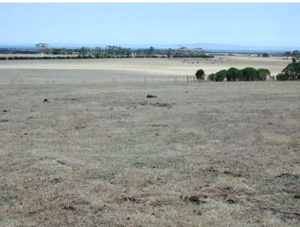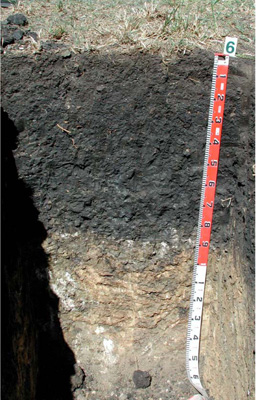CLRA06
Location: Portarlington, Bellarine Peninsula
Australian Soil Classification: Endocalcareous-Endohypersodic, Self-Mulching, Black VERTOSOL
General Landscape Description: Mid slope within low hills.
Geology: Palaeogene Older Volcanics: extrusive tholeiitic and minor alkaline basalts.

CLRA6 Landscape. Low hills near Portarlington
Soil Profile Morphology:
Surface Soil
A11 | 0–10 cm | Very dark grey (10YR3/1); sapric light clay; few (6–20 mm) subrounded quartz gravels; moderate coarse and medium and strong fine subangular blocky structure; rough ped fabric; very firm consistence (dry); pH 7.0; smooth abrupt boundary to: |  CLRA6 Profile | |||
A12 | 10–30 cm | Black (2.5/N); sapric medium clay; few (20–60 mm) angular basalt gravels; moderate medium polyhedral parting to strong fine polyhedral structure; rough ped fabric; strong consistence (dry); pH 7.0; smooth clear boundary to: | ||||
| Subsoil | ||||||
B21 | 30–60 cm | Black (2.5/N); medium clay; very few (20–60 mm) angular basalt gravels; strong coarse prismatic parting to strong coarse and medium polyhedral structure; smooth ped fabric; few prominent slickenside cutans; strong consistence (dry); pH 7.5; wavy diffuse boundary to: | ||||
B22 | 60–80 cm | Black (10YR2.5/1); heavy clay; very few (20–60 mm) angular basalt gravels; strong coarse prismatic structure parting to strong coarse and medium polyhedral structure; smooth ped fabric; few prominent slickenside cutans; strong consistence (dry); pH 8.0; wavy diffuse boundary to: | ||||
BC | 80–100 cm | Dark greyish brown (2.5Y4/2) with few moderate distinct black mottles; light medium clay; few (6–20 mm) angular basalt gravels; strong medium polyhedral structure; smooth ped fabric; very few distinct slickenside cutans; strong consistence (dry); common large calcareous soft segregations; pH 8.5; wavy clear boundary to: | ||||
C | 100–150 cm | Dark greyish brown (2.5Y4/2); coarse sandy clay; common (20–60 mm) angular basalt gravels; apedal massive structure; earthy fabric; very few distinct slickenside cutans; strong consistence (dry); common very large calcareous soft segregations; pH 9.0. | ||||
Soil Profile Characteristics:
Horizon | Sample Depth (cm) | pH (water) | pH (CaCl2) | EC 1:5 | Exchangeable Cations | |||
Ca | Mg | K | Na | |||||
meq/100g | ||||||||
A11 | 0–10 | 7.1 | 6.6 | 0.33 | 16 | 11 | 5.8 | 0.6 |
A12 | 10–30 | 7.3 | 6.6 | 0.2 | 23 | 14 | 4.4 | 1.2 |
B21 | 30–60 | 7.9 | 7.1 | 0.22 | 25 | 24 | 4 | 2.9 |
B22 | 60–80 | 8.5 | 7.6 | 0.25 | 23 | 29 | 2.6 | 4.6 |
BC | 80–100 | 9 | 8.3 | 0.52 | 22 | 43 | 1.3 | 12 |
C | 100–150 | 9.1 | 8.4 | 0.53 | 18 | 42 | 2.4 | 33 |
Horizon | Sample Depth (cm) | Sodium Chloride % | Exchangeable Acidity cmolc/kg | Field Capacity pF2.5 | Wilting Point pF4.2 | Coarse Sand (0.2- 2.0 mm) | Fine Sand (0.02- 0.2 mm) | Silt (0.002- 0.02 mm) | Clay (<0.002 mm) |
A11 | 0–10 | <0.01 | 40.1 | 29.1 | 17.1 | 26 | 15 | 28 | |
A12 | 10–30 | 8.7 | 47.0 | 28.2 | 7.4 | 26.5 | 16.5 | 38.5 | |
B21 | 30–60 | 63.3 | 38.2 | 3 | 22.4 | 16.5 | 51.5 | ||
B22 | 60–80 | 67.5 | 38.3 | 2.5 | 20.6 | 16.5 | 51 | ||
BC | 80–100 | 0.01 | 6.7 | 33.1 | 9.5 | 36 | |||
C | 100–150 |
Management Considerations:
- These cracking soils vary in their workability depending on their moisture status (highly permeable when dry and impermeable when saturated). These soils are also prone to structure decline particularly when worked wet. The high shrink-swell qualities may put high physical stress on roots. They are also generally alkaline with depth and can place stress on roots with their high shrink-swell capabilities. The main priority on these soils is to avoid working when wet (on or below plastic limit).
- The friable (self-mulching) surface soils (and subsoils) occur where there is a build up of organic matter. The surface soil has a high organic carbon content of 6%, but still high in the subsoil (upper subsoil; 2.4%, lower subsoil 2.1%)
- Alkaline subsoils are associated with a high nutrient capacity but result in an imbalance in nutrient availability (may be restrictive to certain plant species (eg. potatoes). These soils are often associated with sodic and calcic soil properties with conflicting effects on soil stability. The upper soils and upper subsoil are slightly dispersive [Emerson class 3(1)] and moderately dispersive at depth [Emerson class 3(4)].
Profile Described By: David Rees (December 2002).


